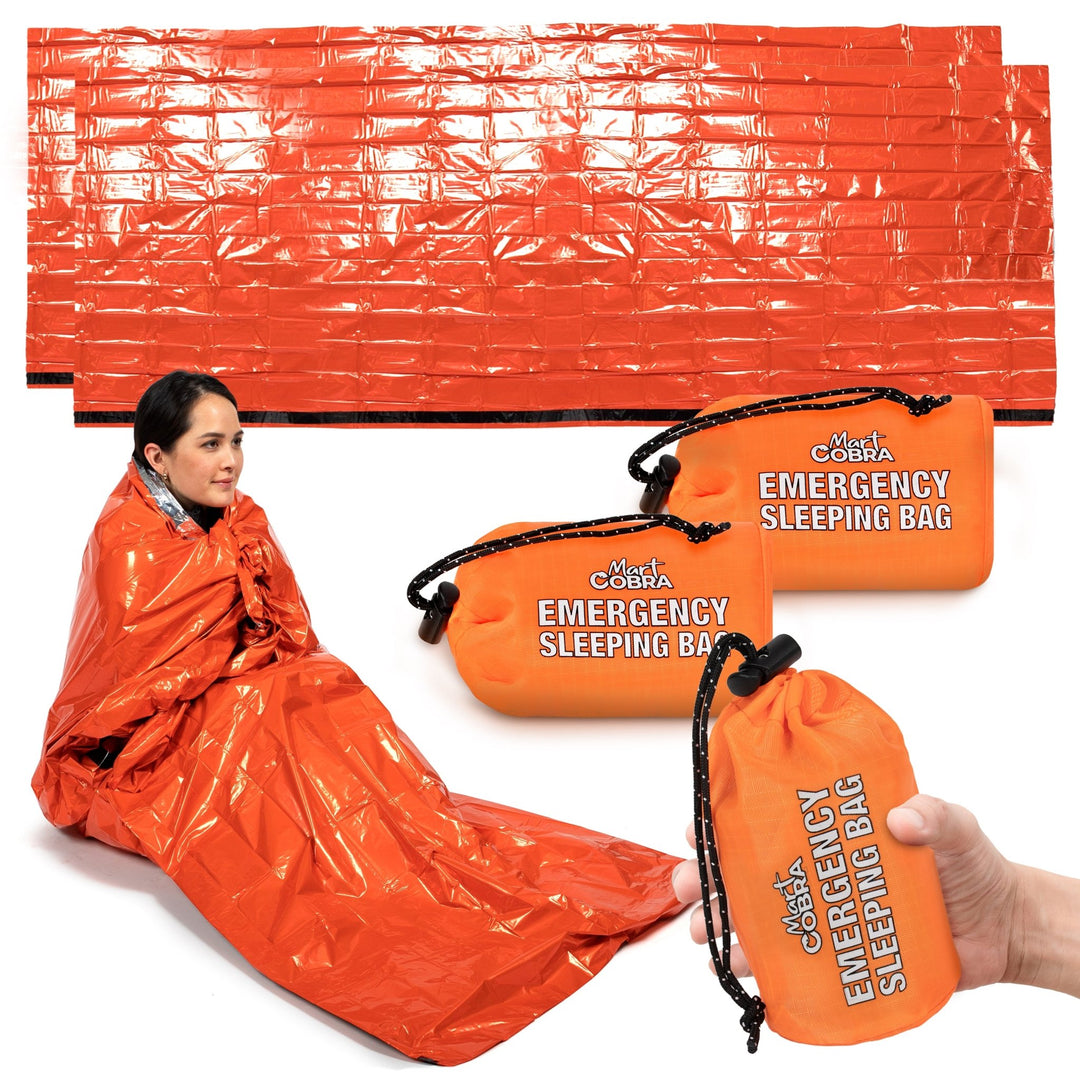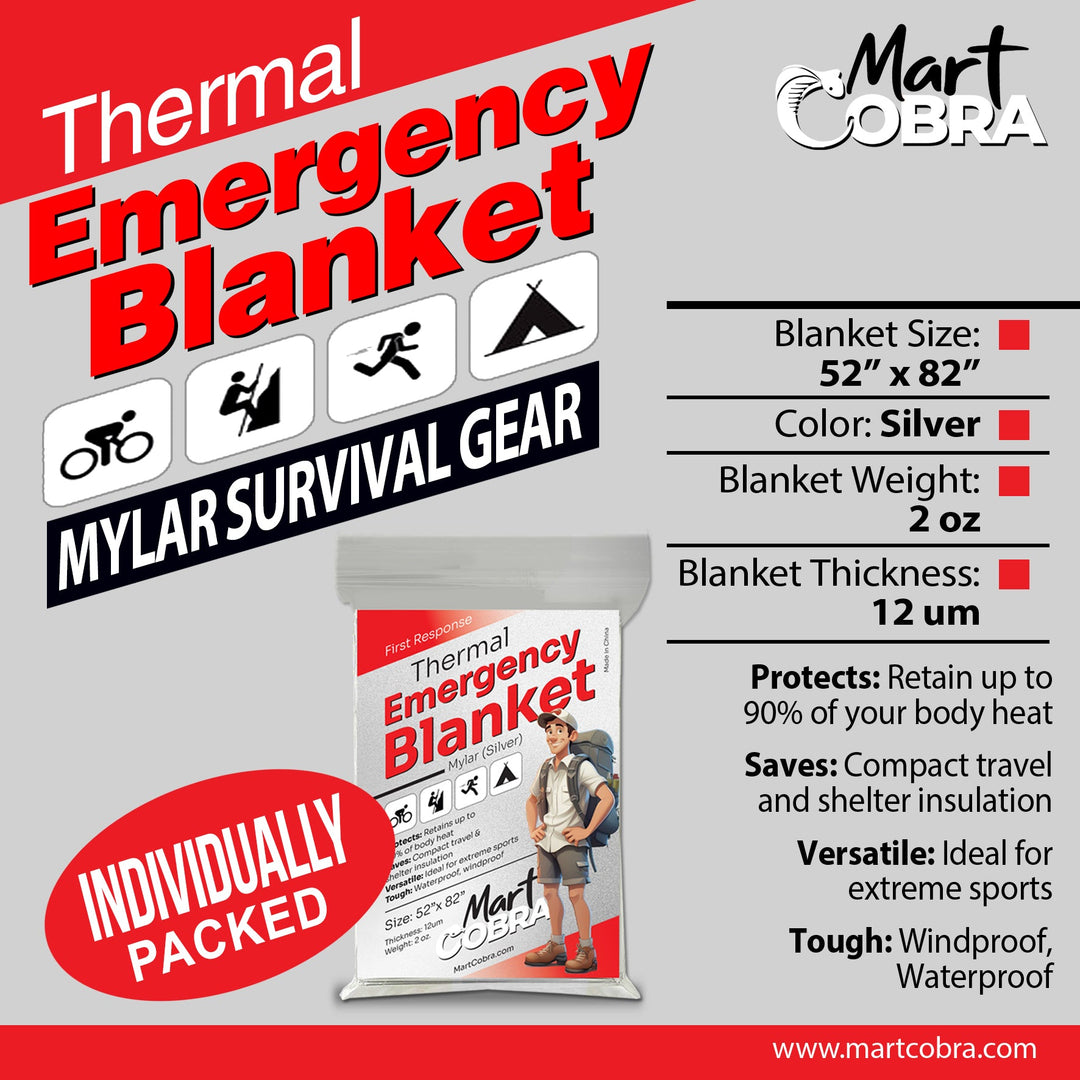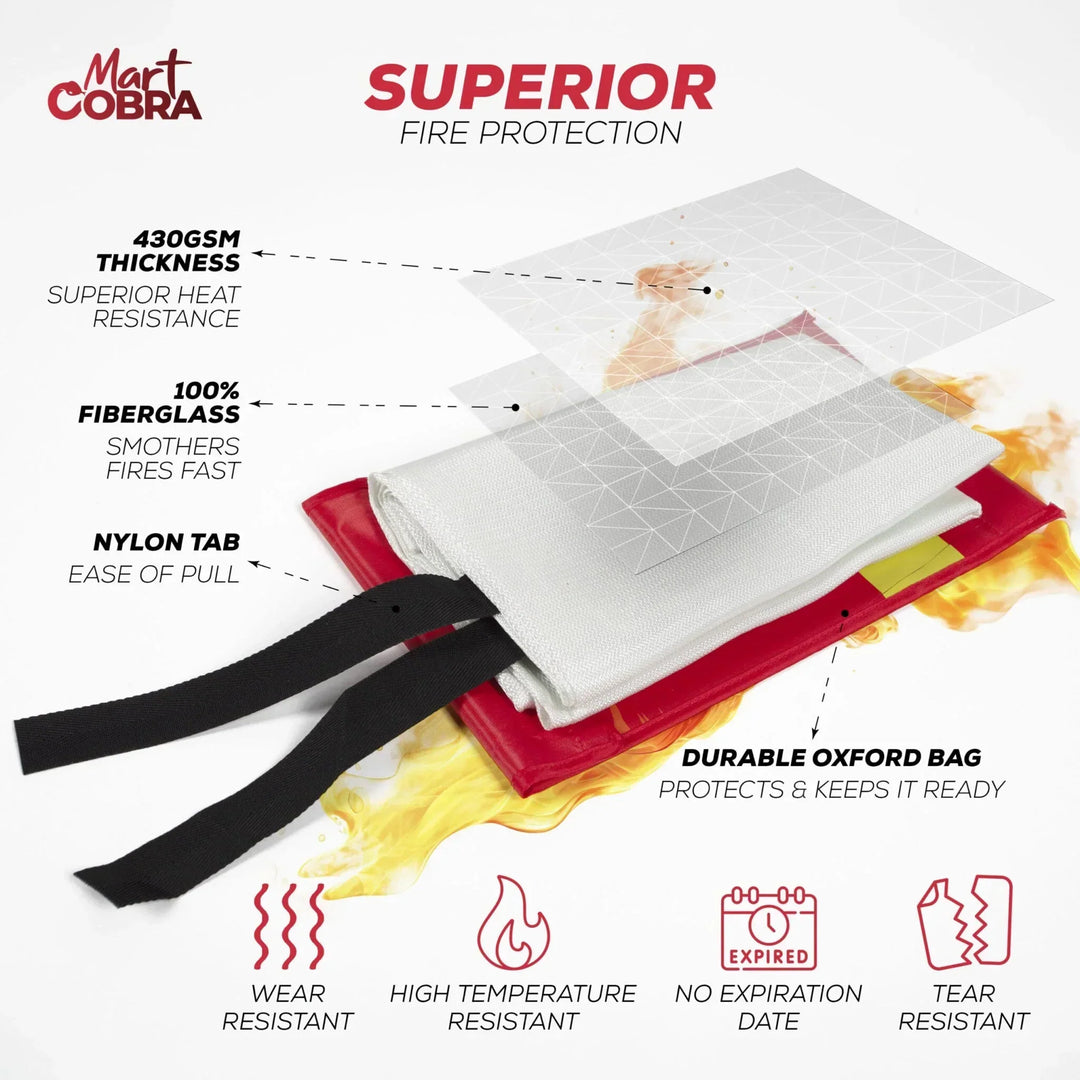In the world of fire safety, deciding between a fire blanket and a fire extinguisher is a big deal. Whether you're a homeowner, small business owner, or just really into safety, knowing which tool works best for your space could be the difference between a minor hiccup and a full-blown disaster.
Fire blankets and extinguishers are both used to put out fires, but they do so in different ways. Let's examine each option to help you determine which tool is best for you.
The Essence of Fire Safety
Before we delve into the comparison, it's crucial to understand the landscape of home and small business fire safety. Year after year,fire incidents ravage property and, even more tragically, claim lives due to a lack of preparedness. This isn't just a statistic; it's a call to action.
Assessing Risk
To safeguard your environment, start with a risk assessment. Identify potential fire sources, combustible materials, and evacuation needs. It is also an ideal time to review exits, fire alarms, and emergency contacts.
The Right Tool for the Job
Once you've identified the risks, ensure you have the right firefighting gear. This can include fire blankets, fire extinguishers, smoke alarms, and escape planning essentials. They're your first line of defense to contain or suppress a fire until emergency services arrive.
Knowing how to put out a small fire is essential, but it's equally crucial to recognize that not all fires are alike. Various types of fires demand different methods for containment and suppression. This is where understanding the distinction between fire blankets and fire extinguishers becomes essential.
Understanding Fire Blankets
What is a Fire Blanket?
Afire blanket is a safety device designed to extinguish small fires at their initial stage. It consists of a sheet of fire-resistantmaterial, typically fiberglass or a similar substance, which can be placed over a small fire to smother it.
Compact and easy to use, fire blankets are particularly effective againstsmall fires in the kitchen, such as those originating from cooking oil or a stovetop. They are also helpful in smothering clothing fires or wrapping around a person to put out flames.
Unlike fire extinguishers, which can spread a grease fire, causing it to grow into flames, fire blankets deprive the fire of heat source and oxygen, effectively suffocating it until it extinguishes.
With that being said, fire blankets are an indispensable tool in anyfire safety kit. They do not require professional maintenance and are suitable for individuals without firefighting training.
What is an emergency fire blanket?
Anemergency fire blanket is specifically designed for use in emergencies, such as residential or small business fires. This is because they are often more compact and easily accessible than traditional fire blankets, making them ideal for quick deployment in high-stress situations. Among other features, emergency fire blankets may also be equipped with reflective strips for better visibility in low light or handles for easy maneuvering.
How Do Fire Blankets Work?
Fire blankets work by depriving the fire of oxygen, which is essential for fueling flames. When a blanket is draped over the flame or a burning object, it creates a tight seal, blocking out air and smothering the fire. This prevents the flames from reigniting, significantly reducing the risk of further spreading.

How to Use a Fire Blanket?
- Remove the fire blanket from its packaging.
- Hold it by the corners and avoid touching the center, as it may be hot.
- Gently place the blanket over the fire source to smother the flames.
- Leave in place for at least 15-20 minutes to ensure complete extinguishing and cooling of any remaining embers.
When to Use a Fire Blanket?
Fire blankets are typically used in scenarios involvingClass F fires, such as
- In a kitchen setting, for cooking oil or grease fires
- In garage or workshop areas where flammable liquids are being used
- When an individual's clothing catches fire
- In a situation where a small, contained fire breaks out
Understanding Fire Extinguishers
What is a Fire Extinguisher?
Afire extinguisher is a portable device that suppresses small to medium-sized fires. It consists of a cylindrical pressure vessel that contains an extinguishing agent, which can be discharged to combat flames. The agents vary—water, foam, dry chemical, carbon dioxide, or a wet chemical—each designed to tackle specific and differenttypes of fires, categorized as Class A, B, C, D, or K in the United States.
How Do Fire Extinguishers Work?
Unlike a fire blanket that suffocates a fire, fire extinguishers work by separating the fuel from oxygen or disrupting the chemical reaction within the fire. The way an extinguisher works varies depending on its type. Therefore, knowing which type is suitable for the specific fire you're dealing with is essential.
How to Use a Fire Extinguisher?
-
Pull the pin: Before discharging the extinguishing agent, remove the safety pin located on top of the extinguisher.
-
Aim at the base: Point the nozzle at the base of the fire, aim low, and sweep from side to side.
-
Pull the lever: Squeeze the handle/trigger to release the extinguishing agent.
-
Sweep from side to side: Move steadily until the fire is entirely out.
- Continue monitoring: Even after using a fire extinguisher, it's crucial to monitor the area in case of re-ignition.
When to Use a Fire Extinguisher?
Fire extinguishers are typically used in scenarios involving Class A, B, C, D, or K fires, such as
- In office buildings and public spaces
- Forelectrical fires
- If there is a risk of explosion (Class C)
- For flammable liquids and gases (Class B)
- For combustible metals (Class D)
- In commercial kitchens for cooking oil or grease fires (Class K)

Advantages of Fire Blankets
Fire blankets provide numerous benefits, making them indispensable tools for fire safety and emergencies. These benefits include:
-
Easy to Use: Fire blankets are highly user-friendly and straightforward to deploy in emergencies. Their uncomplicated design enables anyone to swiftly and effectively extinguish small fires without requiring extensive training.
-
No Maintenance Required: Unlike fire extinguishers, fire blankets don't require regular maintenance, making them a cost-effective, one-time purchase.
- Non-toxic: A fire blanket does not emit harmful chemicals or leave behind residue, making it safe for household use, especially in the kitchen or where food is prepared.
-
No Mess: Unlike fire extinguishers, which can leave a powdery residue, fire blankets do not make a mess, making the cleanup process much easier.
-
Effectiveness on Grease Fires: Fire blankets are particularly effective in extinguishing grease and oil fires, which can be dangerous to tackle with water or a standard fire extinguisher due to the risk of splashing and spreading the fire.
-
Versatility: In addition to smothering flames, fire blankets are used to put out clothing fires and provide protection against heat and flames.
-
Reusable: Some fire blankets can be reused after a fire, depending on the material and if not damaged. This offers long-term value.
- No Training Required: Fire blankets are user-friendly and can be used effectively by anyone, regardless of their level of fire safety knowledge. This makes them suitable for use in various settings such as homes, schools, and workplaces.
Advantages of Fire Extinguishers
Fire extinguishers are invaluable tools for preventing and combatting fires, offering several key benefits:
-
Immediate Response: Fire extinguishers enable a quick andefficient response to fire outbreaks, potentially halting their spread and mitigating damage.
-
Versatility: They can be used on different types of fires, including A, B, C, D, and K, making them suitable for different settings, from homes to commercial spaces.
-
Cost-Effective: Fire extinguishers can significantly reduce property damage and associated repair costs.
-
Accessibility: Fire extinguishers are designed to be easy to locate and use in an emergency. Their widespread availability in public buildings and workplaces enhances overall safety.
-
User-Friendly: While some training is recommended, fire extinguishers are generally easy to operate, even in emergencies. They also allow you to combat fire from asafer distance.
-
Portability: Compact and portable, fire extinguishers can be swiftly carried to the fire scene for rapid intervention.
-
Compliance: Possessing and maintaining fire extinguishers is often a legal requirement in business premises, helping organizations comply with health and safety regulations and avoid potential penalties.
- Environmentally Friendly Options: Many modern fire extinguishers use eco-friendly agents, aligning with green initiatives and sustainability goals.

Comparing Fire Blankets and Fire Extinguishers
When it comes to a head-to-head comparison, there are several factors homeowners and business operators must weigh.
Cost-Efficiency
Fire blankets are less expensive and require minimal maintenance, while fire extinguishers can be refilled, making them more cost-effective over time, especially for handling larger risks.
Effectiveness in Different Scenarios
Fire blankets are ideal for smaller systems due to their straightforward application and lack of chemical residue. On the other hand, extinguishers offer versatility and effectiveness across various fire types.
Maintenance and Usability
Both options require some maintenance to ensure they're ready in an emergency. Fire blankets need regular checks for damage, while extinguishers need inspections and proper training on their usage.
How to Choose the Right Equipment
Here's the million-dollar question: Which option is best for you? The answer hinges on your specific requirements. When choosing the right equipment, consider the size of your space, the type of fire you might encounter, and who will be using it.
Space Size
Fire blankets are ideal for small, confined spaces like kitchens, where swift action against heat is necessary. On the other hand, extinguishers, with their more extended reach, are better suited for larger areas where fires might have the opportunity to spread.
Fire Type
Consider the type of fire most likely to happen in your space. A fire blanket provides swift protection for homes, with kitchen fires being a primary concern. Given its adaptability, a fire extinguisher may be the better bet for industrial settings.
User Capability
A crucial element in your choice is the person using the equipment. While fire blankets are more user-friendly, fire extinguishers require training. Make sure whoever needs these tools is comfortable and knowledgeable about their operation.
Interactive Checklist
Here is a simple checklist to aid in your decision-making process:
- [ ] What is the fire risk in my home or business?
- [ ] Where would the fire potentially start?
- [ ] Who is the primary user of the fire equipment?
- [ ] What are my local fire code requirements?
This checklist will help you assess your personal risk factors and make an informed decision.
Conclusion
When it comes to fire safety, the adage "better safe than sorry" holds particularly true. It's not about over-preparing but about being correctly prepared. The right gear can minimize panic and prevent property damage. Take some time to evaluate your immediate environment, consider the guidelines in this post, and make an informed choice that best suits your situation.
Ultimately, it's not about having equipment on hand but about understanding when and how to use it.Training andfire safety drills are invaluable, potentially even more so than the tools themselves. Keep in mind that effective fire safety requires a mix of the right tools, proper knowledge, and decisive actions. Choose wisely today to ensure a safer tomorrow.
Fire safety drills and training Now is the time to act for those ready to take the next step in their fire safety preparations. Whether purchasing a fire blanket for your kitchen or seeking consultation for industrial fire protection systems, make sure to source reliable, high-quality products. Your safety is non-negotiable, and neither should be your fire safety equipment.







